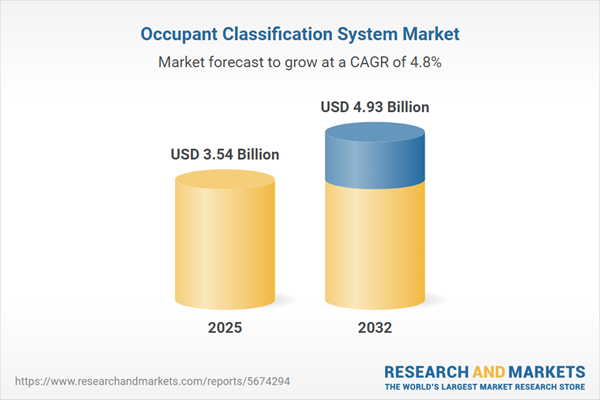Speak directly to the analyst to clarify any post sales queries you may have.
The occupant classification system market is advancing rapidly as automotive stakeholders manage increasing safety requirements, incorporate sophisticated sensor solutions, and navigate changing regulatory landscapes. This report offers senior decision-makers actionable market intelligence to support strategic planning and growth initiatives.
Market Snapshot: Occupant Classification System Market Growth and Direction
The Occupant Classification System Market is positioned for sustained expansion, rising from USD 3.39 billion in 2024 to USD 3.54 billion in 2025. Driven by evolving regulatory expectations and heightened vehicle safety standards, the market is anticipated to grow at a CAGR of 4.80% to USD 4.93 billion by 2032. These figures affirm a steady trajectory fueled by innovation, compliance mandates, and increasing consumer attention to in-cabin safety solutions.
Scope & Segmentation of the Market
This research provides in-depth analysis of key segments and technologies adopted across the occupant classification system market.
- Component: Airbag control units, and sensors including capacitive, infrared, pressure, and ultrasonic types.
- Type: Front seat and rear seat occupant classifications.
- Connectivity: Differentiation between wired and wireless architectures.
- Application: Systems supporting airbag deployment and seat belt reminder functionalities.
- Vehicle Type: Solutions for commercial vehicles (heavy, light, and medium categories) and passenger vehicles (hatchbacks, sedans, SUVs).
- Sales Channel: Aftermarket distribution and original equipment manufacturer agreements.
- Regional Coverage: Americas (United States, Canada, Mexico, major Latin American economies), Europe, Middle East & Africa (with coverage of major and emerging markets), and Asia-Pacific (China, India, Japan, Southeast Asia, and more).
- Company Analysis: In-depth coverage of leading players such as Aisin Corporation, Aptiv PLC, Continental AG, Robert Bosch GmbH, Denso Corporation, and others actively driving innovation and collaboration.
Key Takeaways for Decision-Makers
- Advanced sensing technologies like capacitive and infrared sensors, paired with electronic control units, are central to occupant safety systems in current and future vehicle models.
- Sensor integration is shifting from basic weight detection toward multi-sensor fusion and AI-driven algorithms, enabling systems to distinguish between diverse occupant profiles and respond in real time.
- Growing regulatory scrutiny, particularly concerning airbag deployment accuracy and seat belt reminders, is driving OEMs and suppliers to prioritize R&D partnerships and cross-industry alliances for product differentiation.
- Greater consumer awareness of in-cabin safety and increased adoption of shared mobility platforms are boosting demand for seamless occupant sensing and diagnostic features.
- Regional dynamics reveal unique opportunities: North American and European markets prioritize compliance and premium features, while Asia-Pacific exhibits rapid system integration and cost-driven innovations.
- Both aftermarket solutions and OEM partnerships present important revenue streams, with modular design becoming a key enabler of cost-effective upgrades and fast market adaptation.
Impact of 2025 United States Tariffs on the Supply Chain
Recent tariff policies implemented in 2025 are prompting manufacturers and suppliers to review procurement strategies and consider nearshoring or sourcing diversification to sustain profitability and mitigate risks. Companies are redesigning components for modularity, renegotiating supplier contracts, and expanding regional partnerships to increase supply chain resilience and maintain operational agility.
Methodology & Data Sources
This report draws on a combination of secondary research from industry publications, regulatory filings, technical standards, and patent databases, coupled with primary interviews of key executives, engineers, and regulators. Data triangulation and validation ensure comprehensive, accurate market insights tailored for senior decision-making.
Why This Report Matters for Industry Leaders
- Supports strategic resource allocation by clarifying segment growth, technological priorities, and emerging compliance demands within the occupant classification system market.
- Enables proactive risk management and opportunity identification amid evolving trade policies, standardization efforts, and regional adoption patterns.
- Guides competitive benchmarking by detailing advances and strategic directions among top-tier industry participants.
Conclusion
Occupant classification systems are increasingly vital in supporting automotive safety, regulatory compliance, and consumer trust. This analysis equips decision-makers with the clarity and depth required to capitalize on market evolution and sustain competitive advantage in a transforming industry.
Additional Product Information:
- Purchase of this report includes 1 year online access with quarterly updates.
- This report can be updated on request. Please contact our Customer Experience team using the Ask a Question widget on our website.
Table of Contents
3. Executive Summary
4. Market Overview
7. Cumulative Impact of Artificial Intelligence 2025
Companies Mentioned
The companies profiled in this Occupant Classification System market report include:- Aisin Corporation
- Aptiv PLC
- Continental AG
- CTS Corporation
- Denso Corporation
- Flexpoint Sensor Systems, Inc.
- Forciot
- Hyundai Mobis Co.
- I.G. Bauerhin GmbH
- IEE Smart Sensing Solutions
- Infineon Technologies AG
- International Electronics & Engineering S.A.
- Joyson Safety Systems Aschaffenburg GmbH
- Linepro Controls Pvt Ltd.
- Magna International Inc.
- Nidec Corporation
- Polestar Group
- Renesas Electronics
- Rheinmetall AG
- Robert Bosch GmbH
- TE Connectivity Corporation
- Toyota Industries Corporation
- Volvo Car Canada Ltd.
- ZF Friedrichshafen AG
Table Information
| Report Attribute | Details |
|---|---|
| No. of Pages | 199 |
| Published | November 2025 |
| Forecast Period | 2025 - 2032 |
| Estimated Market Value ( USD | $ 3.54 Billion |
| Forecasted Market Value ( USD | $ 4.93 Billion |
| Compound Annual Growth Rate | 4.8% |
| Regions Covered | Global |
| No. of Companies Mentioned | 25 |









